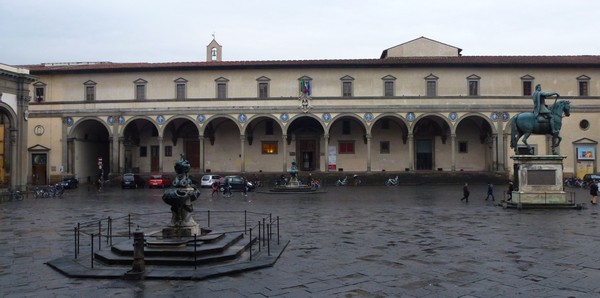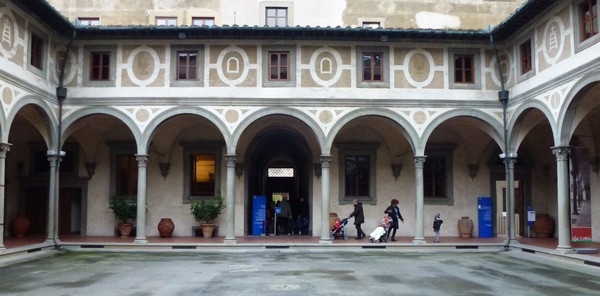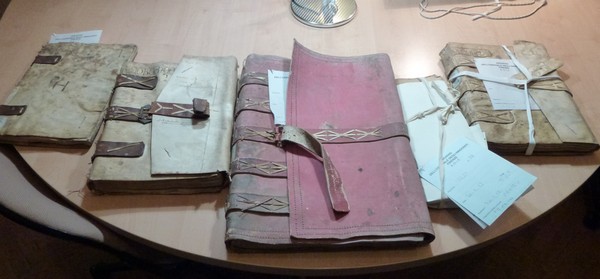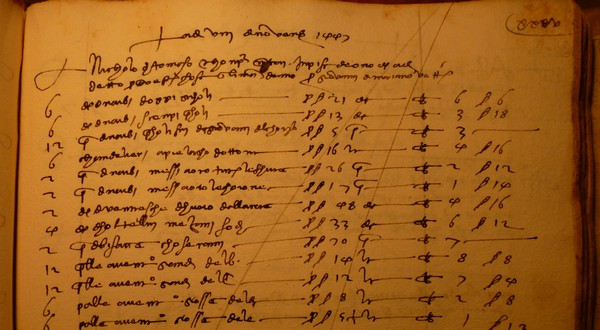Introduction
This research has been carried out in the Archivio Storico dellOspedale degli Innocenti (AOI) in Florence, ensuing from a long research stimulated by new data on imports of Florentine playing cards into Rome in the middle of the 15th century.(1)
The Ospedale degli Innocenti, in Piazza della Santissima Annunziata, is a celebrated building, thanks in particular to the reputation of its architect, nobody less than Filippo Brunelleschi, better known for his Cupola del Duomo.(2) Many documents in AOI concern the specific activity of this Hospital, where the foundlings of the whole town have been accepted for centuries.(3) It is rather common for the AOI to receive now visitors absorbed in the rather hard task to reconstruct their family roots. As a matter of fact, most of the documents here are related to the many children that entered the Hospital and were followed by the administration during their growth.
Of course, in the course of about six centuries of continuous activity, countless administrative documents have also been kept. The main sponsor of this institution was the Florentine Arte della Seta, which included members of the renowned silk manufacture and trade. All of them had to pay a tax to the Hospital; some of these families even left their heritage to it. This tradition was also followed by some families belonging to different categories or professions. As a result, we have now in AOI a whole series of account books and other documents collected in the section labelled as "Estranei"; this name clearly derives from the fact that these documents did not directly belong to the administration of the Hospital, but got there from "extraneous" sources.
If we were interested in the history of silk manufacturing and trade, we could find a lot of interesting documents here, but let us be satisfied with just the minority of books coming from some of the other professions. In particular, I intend to report something interesting from the account books of just one family of merciai, the Puri family.
Puri and other merciai
It is not easy for me to define exactly what a "merciaio" is, and what a merciaio was. The word directly comes from "merce", and merce has an English equivalent in goods, wares, so that the shop may be intended at once as a shop where any goods can be sold and acquired; merchant (or "mercante" here) has exactly the same etymology, but is used for bigger trades.
In the course of time we have assisted to a kind of specialisation, so that a shop of this type still exists nowadays, and is owned by a merciaio, or more often a merciaia, his female counterpart. The major part of the goods on sale is addressed to those few women that still keep the old habit, and competence, to sew something by themselves: here they can find everything they may need, from clothes to ribbons and bands, from buttons to a few metal objects as pins and needles, and so on. Many other metal tools were once available at a merciaio, from nails, shears and knives, up to various professional tools, which now are commonly on sale in an ironware shop.
Both in the UK and the USA I have only spent a few days, and am not familiar enough with the local tradition of similar shops, and corresponding names. I am not sure that the sole word that I find for merciaio in my Zanichelli dictionary, haberdashery, is enough to convey the idea of the particular "shop" we are dealing with here. On the other hand, the English word mercer, which has the same origin and probably corresponds or corresponded - better, is not even present in my Penguin English Students Dictionary.
What I have tried to justify above is that in the store that we intend to visit now more goods are likely to be found than we are ready to expect, and in particular it will be possible to find there packs of playing cards too.
Maybe some information on the family of the owners, Puri, could be useful; this family however is not among the best known in Florence, and I could find no particular information on them. I must however frankly admit that I have only verified that this family was not present among those recorded in Catasto 1427. Further research I did not perform, and thus it is not surprising at all that I did not yet find anything about them - especially considering that I am finding little or nothing even when I do search.
On the cover of the book that will be used below we find a sentence that is noted also in the catalogue of the archive(4) clearly indicating that the owner left Florence and moved to Milan. "A dì 12 novembre 1451 si partì Maso da Firenze et andò al nome di Dio a Melano." After all, let us neglect the information on the family and focus only on the account books that they have left in AOI; who they were is not so much interesting for us, just something that they were trading.
Another point that might be useful to discuss concerns the purchasers. As far as I have understood it, most of the trade, or at least most of the trade of our interest, was from merciaio to merciaio. I have not been able to locate the destination of all the goods sold: in most cases, only the name of the purchaser is indicated, often together with the indication that he is a merciaio.
In a few cases, I have not been able to read the place where the purchasers were active, even if is indicated. However, I am certain that a remarkable part of the playing cards that we will encounter below were sold to purchasers who did not live in Florence. Two of them were certainly from Pisa, one from Pistoia: these three purchasers together may account for a significant part of the trade of our specific interest, say about one third. For instance, the big sale of no less than 160 packs of different qualities recorded on 8 November 1447 was to Nicholo merciaio in Pisa. Another purchaser was active in Dicomano, and another in San Casciano, small country towns not far from Florence, and this is a clear proof that using these cards at the time was current in the countryside too.
One thus obtains the impression that, at least for certain goods, our store acted as a wholesale seller, whereas the colleagues purchasers as sellers by retail. In any case, it is evident that any merciaio coming from a smaller town to make a fresh supply of specific goods in Florence was carrying out a reasonable kind of trade.
I am not sure at all that one can also deduce from the above that playing cards were only produced in Florence at the time; it is of course easy to imagine that here one could find a wider choice of items and prices.
The account books
Six books have been preserved for the Puri family. Let me shortly describe them, using also the corresponding entries in the inventory mentioned.(4)
12617 - 16/09/1413 - 12/11/1457 "Ricordanze A" - cc. 54. This contains private annotations by Piero di Francesco Puri, who was a merchant, matriculated at Arte di Calimala. At the same time, he was employed by the Commune as a "donzello". This book can be considered as a special case, with the five following ones representing another set, associated with his son Tommaso.
The following books mostly correspond to Tommasos activity of merciaio in a few years near the middle of the 15th century. I took a photo of this "set", if it can thus be named. Actually, the five books are very different, both in shape and contents.
12618 - 18/11/1442 - 20/01/1465, «Memoriale G» - cc. 89. This is a kind of intermediate book, in the sense that it appears to have been compiled by both father and son. The various entries in this book appear rather to belong to the domestic administration of the family than to that of their trade. We find, among the most various matters, purchases of poultry, of wine, of Parmesan cheese, and so on. The Hospital emerges as beneficiary of several accounts of money and then half of Pieros heritage.
12619 - 05/09/1447 - 09/08/1450 "Libro rosso A" - cc. 90. This is probably the most important of the series, as also indicated by its dimension, the greatest that could be obtained with the available sheets of paper. We find here more or less long lists of entries collected under the same name of customers or suppliers. Everything is recorded here, but in a form that is not the best for our purpose, because for any entry (corresponding to a further line in the page or part of the page dedicated to the given person) we find the date, the amount of money, the reference to the page of another book where the trade is described in further detail, and nothing else.
12620 - 09/08/1447 - 14/02/1450 «Richordançe A» - cc. 161. This is OUR book! In all the other books indicated I could find no mention of playing cards. (Attention here; this is different from stating that they are not mentioned!) In this book we find many lists of sales, often with enough detail on the various goods, and long lists with their amount and price.
12621 - 01/10/1450 - 29/10/1451 Quaderno di ricordi - cc. 43. This book seems to be the simplest of the series, already on the basis of its unusual dimension, more than 30 cm in height, just about 12 cm wide. It seems to have been used for a first recording of items to be copied later on into the more "serious" books. We find noted various goods, ribbons, knives, bucks, caps, and so on.
12622 - 09/09/1447 - 22/07/1449 «Portate A» - cc. s.n. In this book we find many receipts and quittances noted down day after day - about ten for a page - with attention to names and money amounts, not so much on the items traded.
Before reading the "Richordançe A" book, I had leafed through many others, including several account books, and including a few that apparently were dealing with this kind of objects. Up to now, I had never seen an account book so useful for us as this one, which is the basis for all the information that I report below. The only other place where I could think of finding it is in my bed, in the middle of the night, while sleeping deeply.
Two university professors involved in academic studies on this kind of books had warned me that looking there for playing cards was the same as searching a needle in a hay-stack. I went on nevertheless, but ultimately I was inclined to believe that I was exactly searching in a hay-stack, where absolutely no needle was present. When I was ready to close this research for ever, here it emerges a stack full of needles, in the book of this merciaio, who - by the way - precisely needles was selling in big amounts too. Let me thus extract from "Richordançe A" what is most interesting for us.
Naibi "dozzinale"
As a matter of fact, the material collected in this book is extremely various. Each entry also has a various length, from a single item to long lists of them, in a few cases longer than a whole page. The nature of the goods is evident on first inspection, and exactly corresponds to both kinds of wares indicated at the beginning. On the one hand we have lists of textiles and similar goods, on the other hand long lists of ironware; in a number of cases, we cannot be surprised to find, gathered together, items belonging to both sectors indicated.
Fortunately for us, there are further objects too, and more than once we can read a word that is not at all familiar to common readers, but is one of the most hunted by us: naibi! To find this word in common use far from Florence requires a long travel to Spain or Portugal, but here it lasted longer than in other towns nearby.
The frequency of these references is easily seen, together with the relevant data, in the following two Tables, which I have extracted from "Richordançe A" (obviously, entries recorded there on the same day are part of the same sale). I prefer to report these items in two different groups, common and special cards something that is known, in a way or another, among card collectors.
Here I need however first to define what I intend here as common cards, because some of them may actually be little known, or even not at all. To explain what I mean here for common, I need to introduce another word, the Italian attribute of "dozzinale". In my Zanichelli dictionary I find for it: cheap(-looking), second-rate, commonplace. Probably, its meaning is correctly translated, but I would insist on the origin of our word, directly from dozzina or dozen, namely something that is commonly sold by the dozen, something that, as a corollary, cannot be of a particularly high quality. Precisely by the dozen were sold most of the cards recorded in our book, and I keep them separate from the others, even if most of you will find far from common more than one half of these packs.
The problem (for you) is that a remarkable part of these packs sold by the dozen are not single ("scempio") packs, but are double ("doppio") packs. We possibly find again a slight difference between English single and Italian scempio. Maybe another short digression on the Italian lexicon is thus required, about this scempio attribute: it is not a very common word, also because the opportunities to use it are not many. If you ask for a given item to be sold as "scempio", this implies that it is NOT usually sold as such. To exaggerate a little, it is as if you ask for acquiring just one cigarette instead of a pack, or if you ask for just one rose taken out of its bunch. (In the present case, the word is used in comparison with a pair, not a whole bunch, but its meaning remains the same at the moment, I am not able to recall to my mind something usually sold as a pair, from which you may just ask a single item.)
We are now ready to inspect the following Table, where these cards are listed: they are all of the "dozzinale" kind, but more than half of them cannot be considered as common, I mean if seen from today. On the other hand, here we find no difference in dimension: all packs belong to "picholi", the smaller version.
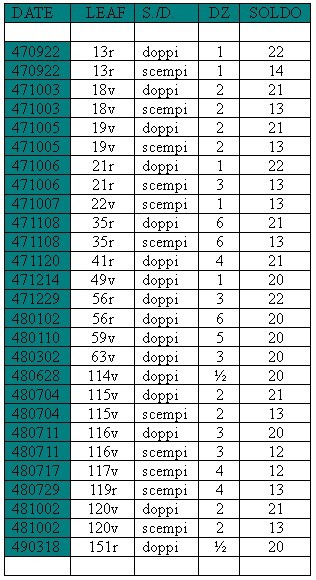
I have indicated the date in the format yymmdd (also for an easier control of the required year change for its first months). The last but one column shows the corresponding amount in dozens and the last one gives the price of one dozen packs. The money amounts are indicated in the book according to the common L.s.d. system, but I have only used here s. or "soldo".
It is evident that this kind of trade was more active in the first months, than later on. It is also possible that we see greater changes than actually occurred, owing to the presence of less detailed records in the last months. It is not clear, on the other hand, if these items became somewhat cheaper or some reduction was offered for greater sales; in any case, the price variation of in the course of time was very small, just plus or minus one soldo, with respect to the price of 21 s. for doppi and 13 s. for scempi.
It is easy to verify that more packs of naibi "doppi" are sold than "scempi": 42 dozens with respect to 30. It is not sure that the resulting ratio of 58% is statistically reliable. A possible influence could be that maybe "scempi" could be easier to find in nearer places. We have to remember the case of other sales in which many triumph packs were recorded together with a single entry of common cards.(5) Anyhow, we must conclude that the double pack was by then in common use, if not really more used than the single one.
As for these double packs: please, do not try to convince me that either their width or height could be twice as usual. You may try and suggest such a possibility for thickness, thinner as scempi, thicker as doppi. In this hypothesis too, however, the number of cards in both packs would be the same and it would be easy to change just one of the intermediate sheets within each card, at about the same cost.
On my part, I must confess that I still believe in arithmetic, and that for me twice 48 is 96. Whether these 96 cards could be an early version of "our" 97-card pack, independent of the existence and use of the name with which it became known a few years later, is a decision so hard to reach that I must leave it open to the profound reflection of the various experts. By the way, however, it is known that one possible explanation of the word "germini" itself has been recurrently traced back to Gemini, or Gemelli, that is twins; now, the distance from a double pack to a twin pack is rather short.
To anybody, who is not yet ready to accept this "peculiar" view of our double pack, the following very simple solution is available. Precisely as today we are accustomed to play some games (for example of the Rummy family) either with a single pack or a double one, we can imagine that we had then in Florence a fashion game that required either single or double packs, with the double one just intended as containing two identical single packs together present. This hypothesis I throw as a useful safety-belt to any skeptical reader, who is groping in the ocean, whereas at the same time I wink at the few skilled swimmers.
In conclusion, the cheapest packs here on sale (if considering their price reduced to a single card) may become the most surprising of them all. Not only was our "double pack" already in current use, not only was it addressed to common people, but it was also already produced with exactly the same cheap systems of the most common card packs: the cheapest single card produced belonged precisely to this double pack.
Naibi "fini"
There is not only one kind of playing cards indicated under the common denomination of naibi: we find more different packs than we could expect. Let us first conclude our discussion of the "simple" playing cards with a last point worth noting. At the time, one could acquire different kinds of cards, at different prices. When I was a child, a few years later than one could actually visit this merciaio store in person, we had two kinds of local cards, of course Fiorentine grandi, but also Toscane piccole, with exactly the same figures appearing on the cards. I did not imagine that this difference in card dimension could have such a long tradition.
It would be too simple to have just to decide between small or large cards: we find more than two kinds of specimens; mezzani or middle are also on sale, if we move to packs of better quality. If we have enough money, in the middle of the 15th century, we can buy products sold at various prices; when they are indicated as "richi", or "fini", there is no doubt about their superior quality.
I have thus kept all the cards that were sold as single packs, instead of by dozen, separately listed. When introducing low and better quality, the problem of choosing the most suitable pack may become embarrassing - there could hardly be a limit toward the best qualities that one could look for. The variation in price for a given pack is thus very high, as it can be verified in the following Table: here you can select one pack that costs remarkably more than a whole dozen of the previous ones.
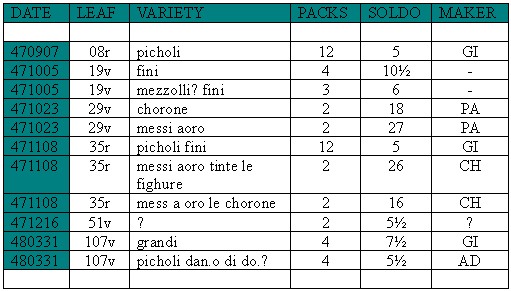
Several columns are the same as in the previous Table. The middle one here adds some indication on the pack in question. Then here we have the number of packs (instead of the dozens as in the previous Table) and their individual prices. In the last columns the makers are indicated, with GI for Giovanni di San Giovanni, PA for Paparello, and CH where chorone (crowns) are mentioned, see below.
It is worth noting that the time interval for these records is reduced to half a year, end 1447 - beginning 1448, remarkably shorter than for dozzinale packs of the first Table. Again, it is not clear if any reliable conclusion on card trade can be deduced from this, because there are further variables to consider, such as a shorter notation for the last entries.
We find here both picholi and grandi, but no mention of either scempi or doppi. This is a problem for understanding which were these packs from that point of view, but the ratio slightly less than two that would exist in corresponding prices is not so big, with respect to the higher ratios between these prices and those of "dozzinale" packs. A possibility is that Paparello-chorone packs at 16-18 s. were scempi, whereas those at 26-27 were doppi, but there is another plausible explanation for the more expensive packs, which not only had gilded crowns, but also carefully painted figures.
What seems to me particularly interesting is that you enter the store and have the choice among various kinds of packs, all of them ready to be sold. This is not so surprising for the cheap items, sold and bought by the dozen. There is however something else, also available onto the shelves, something of an increasingly better quality. Among the corresponding makers, we find names that can easily be compared with those renowned masters, who at the same time were producing their famous packs for the courts of Milan and Ferrara: Giovanni and Paparello were at least at their level. There is a big difference, however. Here, any merciaio can enter the store and acquire a pack made by one of the best painters, and without having to order it and waiting for weeks that it is finished.
Almost one half of these entries corresponding to costly packs are associated with Giovanni da San Giovanni as a painter. Apparently he provided the workshop with a large stock of packs ready to be sold, in a way that may be considered intermediate with respect to "dozzinale" packs. Indeed, we find in no less than two cases that his packs are sold in groups of twelve nevertheless they are numbered and priced on the basis of single packs and not of dozens. Their price of 5 s. is intermediate between the packs of the first Table and the remaining ones, made with seemingly better quality and additional gold decoration.
One maker (an.o di do.o?) I have not been able to read. The painter who provides the most expensive packs is Paparello, whom we met in the list by Jacobsen(6). I read for some of these packs the word "oro" and the words "le chorone". In my opinion, the simplest interpretation is that the personages on these cards had their crowns directly gilded. In one case we find both chorone and Paparello in the description, and it seems possible that Paparello was the painter in all cases in which chorone are mentioned. In any case, the highest price corresponds to both gilded crowns and painted figures.
An extraordinary cardmaker
Several names of cardmakers and painters of playing cards who were active in Florence in about those years can be found here and there, but in Richordançe A we find one, who may be more interesting than all the remaining ones: Giovanni da San Giovanni. San Giovanni Valdarno is the present name of a country town that near the end of the 13th century had been built by the Florentines, with the name of Castel San Giovanni, as a fortified settlement in front of Arezzo (not to forget that San Giovanni Battista is still considered as the patron of Florence).
Our Giovanni painter was born there but, as it occurred for many artists, he lived and worked in Florence; this he did after having been active as a soldier in his youth. His outstanding plus point is not so much due to his personal value as a painter, however remarkable, but rather to that of his elder brother, nobody less than Masaccio. For Masaccio, let me add here just his dates of birth and death, 1401-1428 he has been so great an artist that it is easy to get whatever information one may wish about him. His full name was Tommaso di ser Giovanni Guidi da San Giovanni; his younger brother was born in 1406, soon after the death of their father, so that he could take the same first name: Giovanni di ser Giovanni, then nicknamed Lo Scheggia.(7)
I could read no less than three whole books dedicated to him, (8,9,10) where I could not find (yet) any trace of playing cards. It may be worth noting however that, while he is not known as a painter of triumphal cards, he is renowned for some of the triumphal processions that he painted on cassoni, the big and finely decorated trunks that were part of the marriage settlements of the brides.
Art historians should be warned not to expect that the revolutionary style of Masaccio could be passed to his brother as a painter of playing cards. Here no revolutionary improvement in style is welcome: the aim of the work is just to satisfy the conservative attitude of the players, who always prefer, and by far, that their traditional images are changed the least as possible.
I feel the last practical point is not taken sufficiently into account by art historians, when they pay some attention to playing cards, en passant. It is therefore a pleasure for me to provide them with the documented name of a painter, whom they already know from different productions. Even if art historians have written little or no pages about him as a card painter, I feel certain that they will soon find their remedy to this, with new hundreds of pages. There is an additional advantage: I give them exact dates for these cards, but thanks to the long life of this artist, it will be unlikely for them, in this case, to attribute to a painter cards produced before his birth or after his death.
Conclusion
The records of Florentine playing cards imported into Rome has stimulated me to carry out a research(1) in the Florentine archives. After reading many books of various kinds with no useful result, I could find one of them overloaded with the wanted detail. We thus learn several new facts on the trade of playing cards in Florence, in the middle of the 15th century.
There were various kinds of packs on sale, to begin with ordinary ones, sold by the dozen. They all belonged to the "piccoli" kind, with mezzani and grandi only present among the more costly specimens. However, we unexpectedly learn that double packs were already in common use, and it is rather demanding not to associate them with the typical Florentine pack, later known as minchiate or germini. These were common packs by then, even if most of my readers, accustomed to hang around the prince courts of the Po valley, may not be prepared to absorb this information promptly enough.
Alongside with these "common" packs, there was a whole choice of more costly ones on sale, even signed by renowned painters of the time. Some of these painters, as Paparello, we already knew as involved in card production, but here we find another painter, Giovanni di Ser Giovanni, nicknamed Lo Scheggia, the brother of Masaccio, who is already well known among art historians.
As a conclusive comment, let me state that what I have listed is certain: I have mentioned all the cases in which I found naibi in book Richordançe A; I can also add that I recorded only these cases. However, I am not able to finish this statement in the usual way: I cannot swear to have reported all the naibi mentions that exist in the book. Maybe you will soon visit the archive and find, even in the same book, a lot of new entries that escaped my observation. Good luck.
Footnotes:
(1) Franco Pratesi: Early Playing Card Exports in Florence ?
(2) Wikipedia: Opedali degli Innocenti
(3) Istituto degli Innocenti / Webpage
(4) Istituto degli Innocenti / Research
(5) Franco Pratesi: 1453-1458 Florentine triumphs by Filippo di Marco
(6) Franco Pratesi: Cardmakers and Woodblocks on Trial
(7) Wikipedia: Giovanni di ser Giovanni Guidi
(8) Laura Cavazzini, Il fratello di Masaccio : Giovanni di Ser Giovanni detto lo Scheggia. Maschietto & Musolino, Firenze 1999.
(9) Luciano Bellosi, Lo Scheggia. Maschietto & Musolino, Firenze 1999.
(10) Alessandro Delpriori, La giovinezza dello Scheggia e una Madonna col bambino allalba del Rinascimento. Frascione arte, Firenze 2011.
Side bar pictures and text added by Lothar Teikemeier
|
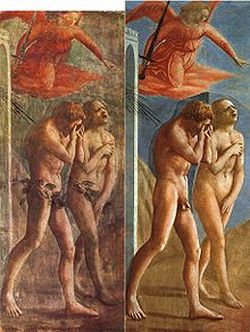
Famous Masaccio, brother of Giovanni da San Giovanni nicknamed "Lo Scheggia" (who made playing cards), painted this picture (left: forged for reasons of sexual moral; right restored to the original version)
Minchiate decks of 18th and 19th century had these motifs for the Tower cards:
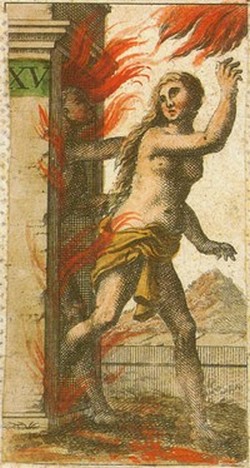
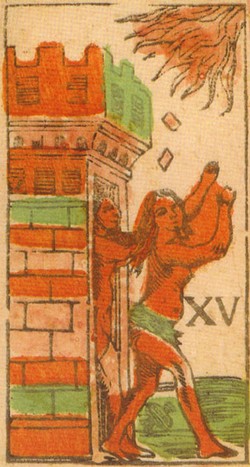
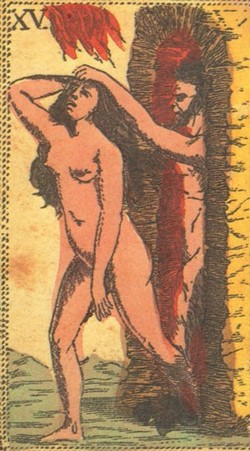
|
|


